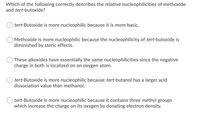
Organic Chemistry: A Guided Inquiry
2nd Edition
ISBN: 9780618974122
Author: Andrei Straumanis
Publisher: Cengage Learning
expand_more
expand_more
format_list_bulleted
Question

Transcribed Image Text:Which of the following correctly describes the relative nucleophilicities of methoxide
and tert-butoxide?
tert-Butoxide is more nucleophilic because it is more basic.
Methoxide is more nucleophilic because the nucleophilicity of tert-butoxide is
diminished by steric effects.
These alkoxides have essentially the same nucleophilicities since the negative
charge in both is localized on an oxygen atom.
tert-Butoxide is more nucleophilic because tert-butanol has a larger acid
dissociation value than methanol.
tert-Butoxide is more nucleophilic because it contains three methyl groups
which increase the charge on its oxygen by donating electron density.
Expert Solution
This question has been solved!
Explore an expertly crafted, step-by-step solution for a thorough understanding of key concepts.
This is a popular solution
Trending nowThis is a popular solution!
Step by stepSolved in 2 steps

Knowledge Booster
Learn more about
Need a deep-dive on the concept behind this application? Look no further. Learn more about this topic, chemistry and related others by exploring similar questions and additional content below.Similar questions
- Rank the following reactions in order of increasing nucleophile strength: Cl-, H2O, CH3-, H2S, HS-, I-arrow_forward15. Which of the following correctly describes the relative nucleophilicities of methoxide and tert- butoxide? A) These alkoxides have essentially the same nucleophilicities since the negative charge in both is localized on an oxygen atom. B) Methoxide is more nucleophilic because the nucleophilicity of tert-butoxide is diminished by steric effects. C) tert-Butoxide is more nucleophilic because it contains three methyl groups which increase the charge on its oxygen by donating electron density. D) tert-Butoxide is more nucleophilic because it is more basic. E) none of the above 16. Rank the species below in order of increasing nucleophilicity in protic solvents: CH3CO2-, CH3S-, HO-, H2O. Answer: A. H2Oarrow_forwardBenzyl bromide (C6H5CH2Br) reacts rapidly with CH3OH to afford benzyl methyl ether (C6H5CH2OCH3). Draw a stepwise mechanism for the reaction, and explain why this 1° alkyl halide reacts rapidly with a weak nucleophile under conditions that favor an SN1 mechanism. Would you expect the para-substituted benzylic halides CH3OC6H4CH2Br and O2NC6H4CH2Br to each be more or less reactive than benzyl bromide in this reaction? Explain your reasoning.arrow_forward
- Please don't provide handwritten solution ...arrow_forwardWhen drawing organic chemistry mechanisms with NaOCH3, do we automatically dissociate it into Na+ and OCH3-, making it easier to go through SN2 and/or E2 reactions? Does NaOCH3 dissociate, and is this why it is a strong nucleophile?arrow_forwardWhich reagent in each pair listed here would be the more reactive nucleophile in a polar aprotic solvent? CH3NH– or CH3NH2 CH3O− or CH3CO−2 (−OAc) CH3SH or CH3OH (C6H5)3N or (C6H5)3Parrow_forward
- For each compound predict if it's positive or negative for AgNO3/EtOH Test (SN1), propose 1 sentence explanation why. 2-Bromobutane 1-bromobutane 2-Chlorobutane 1-chlorobutane t-butyl chloride benzyl chloride bromobenzene bromocyclohexane bromocyclopentanearrow_forwardWhich statement best explains why aldehydes are generally less reactive than ketones? Aldehydes are less sterically hindered Aldehydes have one less electron donating alkyl group so the carbonyl C is a better electrophile. Both of the choices above: Aldehydes are less sterically hindered and they have one less electron donating alkyl group so the carbonyl C is a better electrophile. Ketones are generally more reactive than aldehydes.arrow_forwardCan you explain it? How to find the answer? And the various factors that involved E2? What is the difference between the options? What determine nucleophile is better in protic/aproticarrow_forward
- The compound below is treated with N-bromosuccinimide (NBS) in the presence of light. Draw both resonance structures for the radical produced by reaction of the compound with a bromine atom. Assume reaction occurs only at the weakest C-H bond.arrow_forwardRank the following alkyl halides in term of reactivity in a E2 reaction with NaOH (fastest (1) to slowest (4)): 1-bromo-2,2-dimethylpentane, 1-chloro-2,2-dimethylpentane, 2-chloro-2-methylpentane, and 2-bromo-2-methylpentane.arrow_forwardHelparrow_forward
arrow_back_ios
SEE MORE QUESTIONS
arrow_forward_ios
Recommended textbooks for you
 Organic Chemistry: A Guided InquiryChemistryISBN:9780618974122Author:Andrei StraumanisPublisher:Cengage Learning
Organic Chemistry: A Guided InquiryChemistryISBN:9780618974122Author:Andrei StraumanisPublisher:Cengage Learning Organic ChemistryChemistryISBN:9781305580350Author:William H. Brown, Brent L. Iverson, Eric Anslyn, Christopher S. FootePublisher:Cengage Learning
Organic ChemistryChemistryISBN:9781305580350Author:William H. Brown, Brent L. Iverson, Eric Anslyn, Christopher S. FootePublisher:Cengage Learning

Organic Chemistry: A Guided Inquiry
Chemistry
ISBN:9780618974122
Author:Andrei Straumanis
Publisher:Cengage Learning

Organic Chemistry
Chemistry
ISBN:9781305580350
Author:William H. Brown, Brent L. Iverson, Eric Anslyn, Christopher S. Foote
Publisher:Cengage Learning